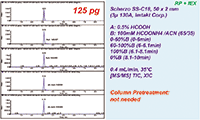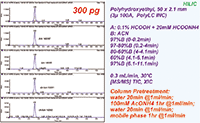Comparison of Multi-Mode Scherzo SS-C18 and HILIC Mode Column in the Retention
The Application Notebook
A novel method for the retention and quantification of polar neurotransmitters is presented. A reversed phase method using Scherzo SS-C18 column is compared to a HILIC method using a Polyhydroxyethyl column.
When analyzing highly polar compounds by reversed phase HPLC there exist several challenges, the most obvious of which is that polar compounds are difficult to retain using non-polar stationary phases like C18. A common solution is the use of aqueous normal phase or HILIC methods with stationary phases that can be wetted and that retain this aqueous layer on the surface of the particle. The difficulty in using HILIC methods is that the wetting process can often be quite lengthy, and maintaining a consistent aqueous surface is difficult.
In the example shown here we seek to provide an alternative to HILIC methods by using a novel multi-mode column called the Scherzo SS-C18. This stationary phase has both reversed-phase (C18) and polar components with the addition of a high density of strong anion and cation exchange ligands. This strategy for increasing polar retention is much more predictable run to run and does not require lengthy column pre-treatments.
Experimental Conditions
MRM transitions and running conditions are within chromatograms.
Experimental data courtesy of Dr. D. Koop, Oregon Health and Sciences University, Portland, OR.
Results and Discussion
Chromatograms of the neurotransmitter acetylcholine using Scherzo SS-C18 and HILIC columns are shown in Figure 1 and Figure 2, respectively.

Both columns shown in Figure 1 and in Figure 2 retain the neurotransmitter acetylcholine well. Two instant observations are peak shape and detection limits. In particular, despite longer retention (~ 20% more), the peak shape on Scherzo SS-C18 is better as evident by peak width at half height which is about 50% of the HILIC column. This observation indicates overall significantly better performance of a Scherzo SS-C18 column and higher peak capacity that leads to better separations. This also contributes to a roughly 2.5X increase in sensitivity with the Scherzo SS-C18 column compared to the HILIC column (125 pg vs. 300 pg).

At approximately 3 min of retention, both methods can be justified for high throughout applications, however, considering the long and kinetically-slow conditioning on the HILIC column, we feel that Scherzo SS C-18 is a better choice. In contrast, the HILIC column, while it has comparable run times, requires over 2.5 h conditioning in this application, practically disqualifying this HILIC column for high throughput use.
Conclusion
The multi-mode Scherzo SS-C18 column shows great promise in successful retention of small, polar molecules (e.g., neurotransmitters). The column retains these types of analytes as well or better than a HILIC column, it has excellent sensitivity, eluents are MS-friendly, and, most importantly, it does not need lengthy conditioning. This feature alone significantly reduces overall separation times and operation costs, which potentially makes this column an attractive alternative for separation of polar analytes.

Imtakt USA
1104 NW Overton St., Portland, OR 97209
tel. (888) 456-HPLC, (215) 665-8902, fax (501) 646-3497
Website: www.imtaktusa.com

Free Poster: NDSRI Risk Assessment and Trace-Level Analysis of N-Nitrosamines
April 25th 2025With increasing concern over genotoxic nitrosamine contaminants, regulatory bodies like the FDA and EMA have introduced strict guidelines following several high-profile drug recalls. This poster showcases a case study where LGC and Waters developed a UPLC/MS/MS method for quantifying trace levels of N-nitroso-sertraline in sertraline using Waters mass spectrometry and LGC reference standards.
New TRC Facility Accelerates Innovation and Delivery
April 25th 2025We’ve expanded our capabilities with a state-of-the-art, 200,000 sq ft TRC facility in Toronto, completed in 2024 and staffed by over 100 PhD- and MSc-level scientists. This investment enables the development of more innovative compounds, a broader catalogue and custom offering, and streamlined operations for faster delivery. • Our extensive range of over 100,000 high-quality research chemicals—including APIs, metabolites, and impurities in both native and stable isotope-labelled forms—provides essential tools for uncovering molecular disease mechanisms and exploring new opportunities for therapeutic intervention.
New Guide: Characterising Impurity Standards – What Defines “Good Enough?”
April 25th 2025Impurity reference standards (IRSs) are essential for accurately identifying and quantifying impurities in pharmaceutical development and manufacturing. Yet, with limited regulatory guidance on how much characterisation is truly required for different applications, selecting the right standard can be challenging. To help, LGC has developed a new interactive multimedia guide, packed with expert insights to support your decision-making and give you greater confidence when choosing the right IRS for your specific needs.
Using the Carcinogenic Potency Categorisation Approach (CPCA) to Classify N-nitrosamine Impurities
April 25th 2025Learn how to manage nitrosamine impurities in pharmaceuticals with our free infographic. Discover how the CPCA approach establishes acceptable intake limits and guides the selection of NDSRI reference samples. Stay compliant and ensure safety with our ISO-accredited standards.

.png&w=3840&q=75)

.png&w=3840&q=75)



.png&w=3840&q=75)



.png&w=3840&q=75)













